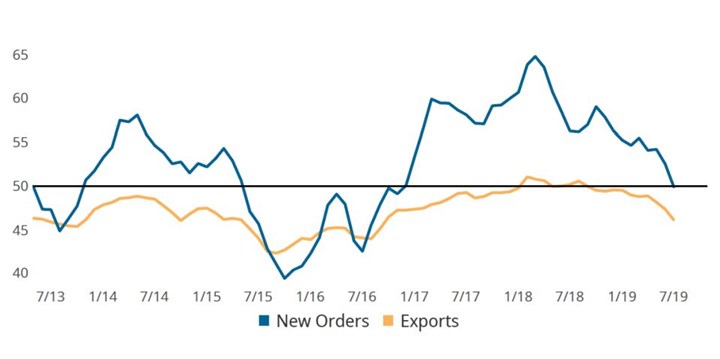July Metalworking Index Cools on New Orders and Backlog
Leading components of the index experience rapid change.
Share

.png;maxWidth=45)
DMG MORI - Cincinnati
Featured Content
View More




Takumi USA
Featured Content
View More

Hwacheon Machinery America, Inc.
Featured Content
View More

Autodesk, Inc.
Featured Content
View More
The Gardner Business Index (GBI): Metalworking registered 47.8, signaling its first contracting reading since December 2016. Index readings above 50 indicate expanding activity while values below 50 indicate contracting activity. The further away a reading is from 50, the greater the change. Gardner Intelligence’s review of the underlying index components observed that the index, which is calculated as an average of its components, was supported by supplier deliveries and employment. The contractionary readings for production, exports, new orders and backlogs pulled the average of the components below a reading of 50. Weak new order activity relative to production sent the backlog reading to its lowest level in almost three years.

New Orders and Exports (3MMA): Export orders have contracted in every month since December 2018; however, total new orders continued to expand, indicating strength in domestic orders. This trend ended in July with total new orders contracting faster than exports.
In a surprising move, total new orders contracted faster than exports for the first time since June 2016. While shops reported decreasing production activity, the decline was not enough to stem an accelerating decline in backlogs. July’s data indicated that only the lagging components of the Index – supplier deliveries and employment – expanded modestly. Since the second half of 2018, all components have indicated slowing to contracting activity.
Related Content
-
Metalworking Activity Stabilizes in July
July closed at 44.2, which interrupts what had been three months straight of accelerating contraction.
-
Metalworking Activity Trends Slightly Downward in April
The interruption after what had been three straight months of slowing contraction may indicate growing conservatism as interest rates and inflation fail to come down.
-
Metalworking Activity Continued to Contract Steadily in August
The degrees of accelerated contraction are relatively minor, contributing to a mostly stable index despite the number of components contracting.

.jpg;width=70;height=70;mode=crop)







.png;maxWidth=150)


















.jpg;maxWidth=300;quality=90)



